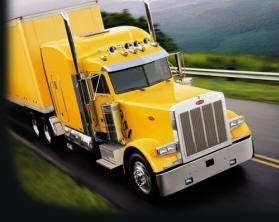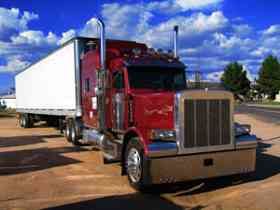Review Questions - Click On The Picture To Begin...

- None of these answers are correct
- Every month
- At least once per week
- At the end of each day
Quote From The CDL Manual:
If your vehicle does not have automatic air tank drains, drain your air tanks at the end of each working day to remove moisture and oil. Otherwise, the brakes could fail.
- All of these answers are true
- Older vehicles may have a round blue knob for the parking brake in place of the yellow diamond shaped knob currently used in modern equipment
- When the brakes are very hot (i.e. just after coming down a steep grade) wheel chocks should be used instead of the parking brake
- When there are freezing temperatures and the brakes are very wet, the brake linings may freeze to the brake drums
Quote From The CDL Manual:
Any time you park, use the parking brakes, except as noted. Pull the parking brake control knob out to apply the parking brakes. Push it in to release them. The control will be a yellow, diamond-shaped knob labeled "parking brakes" on newer vehicles. On older vehicles, it may be a round blue knob or some other shape, including a lever that swings from side to side or up and down.
Do not use the parking brakes if the brakes are very hot (i.e., from just coming down a steep grade), or if the brakes are very wet in freezing temperatures. If the brakes are used when very hot, they can be damaged by the heat. If they are used in freezing temperatures when the brakes are very wet, they can freeze so the vehicle cannot move. Use wheel chocks to hold the vehicle. Let hot brakes cool before using the parking brakes. If the brakes are wet, use the brakes lightly while driving in a low gear to heat and dry them.
If your vehicle does not have automatic air tank drains, drain your air tanks at the end of each working day to remove moisture and oil. Otherwise, the brakes could fail.
Never leave your vehicle unattended without applying the parking brakes or chocking the wheels. Your vehicle might roll away and cause injury and damage
- All of these are ways to help avoid Brake Fade
- Properly calibrating slack adjusters
- Avoiding excessive use of the service brakes
- Making sure all brake linings are in good condition
Quote From The CDL Manual:
Excessive use of the service brakes results in overheating and leads to brake fade. Brake fade results from excessive heat causing chemical changes in the brake lining, which reduce friction and cause the expansion of the brake drums. As the overheated drums expand, the brake shoes and linings have to move further to contact the drums, and the force of this contact also is reduced. Continued overuse may increase brake fade until the vehicle cannot be slowed down or stopped at all.
- Between 100 and 120 psi
- Between 50 and 75 psi
- Between 10 and 20 psi
- Between 20 and 45 psi
Quote From The CDL Manual:
The spring brakes will come on when the air pressure drops into the 20 to 45 psi range
- A predetermined speed for descending down a long or steep grade, which helps determine when brakes should be applied or released
- 10mph under the posted speed limit is considered a safe speed
- The yellow signs before curves and ramps are designated safe speeds
- Speeds of 55mph or below are considered safe speeds for maximum fuel mileage
Quote From The CDL Manual:
Remember, the use of brakes on a long and/or steep downgrade is only a supplement to the braking effect of the engine. Once the vehicle is in the proper low gear, the following is the proper braking technique:
- 1. Apply the brakes just hard enough to feel a definite slowdown.
- 2. When your speed has been reduced to approximately 5 mph below your "safe" speed, release the brakes. (This brake application should last about 3 seconds.)
- 3. When your speed has increased to your "safe" speed, repeat steps 1 and 2.
- Continued overuse may increase brake fade until the vehicle cannot be slowed down or stopped at all
- As overheated drums expand, the brake shoes and linings have to move further to contact the drums, and the force of this contact also is reduced
- Brake fade results from excessive heat causing chemical changes in the brake lining, which reduce friction and cause the expansion of the brake drums
- While brake fade was once a very common problem, it is very rare with modern brake cooling mechanisms
Quote From The CDL Manual:
Brakes are designed so brake shoes or pads rub against the brake drum or discs to slow the vehicle. Braking creates heat, but brakes are designed to take a lot of heat. However, brakes can fade or fail from excessive heat caused by using them too much and not relying on the engine braking effect.
Excessive use of the service brakes results in overheating and leads to brake fade. Brake fade results from excessive heat causing chemical changes in the brake lining, which reduce friction and cause the expansion of the brake drums. As the overheated drums expand, the brake shoes and linings have to move further to contact the drums, and the force of this contact also is reduced. Continued overuse may increase brake fade until the vehicle cannot be slowed down or stopped at all.
Brake fade also is affected by adjustment. To safely control a vehicle, every brake must do its share of the work. Brakes out of adjustment will stop doing their share before those that are in adjustment. The other brakes can then overheat and fade and there will not be sufficient braking available to control the vehicle(s). Brakes can get out of adjustment quickly, especially when they are hot. Therefore, brake adjustment must be checked frequently.
TruckingTruth's Advice:
While engine brakes are a fantastic tool in helping to prevent brake fade, the number one cause of brake failure in hilly conditions is brake fade.
- Fluctuate between "hard braking" and "soft braking" but never fully release the brakes during a downgrade
- Apply the brakes enough to keep a constant speed during the entire downgrade
- Apply the brakes just hard enough to feel a definite slowdown, when your speed has been reduced to approximately 5mph below your "safe" speed, release the brakes and repeat as necessary
- Begin the downgrade at a slow enough speed that brakes will not be necessary during the entire grade
Quote From The CDL Manual:
Proper Braking Technique - Remember, the use of brakes on a long and/or steep downgrade is only a supplement to the braking effect of the engine. Once the vehicle is in the proper low gear, the following is the proper braking technique:
- 1. Apply the brakes just hard enough to feel a definite slowdown.
- 2. When your speed has been reduced to approximately 5 mph below your "safe" speed, release the brakes. (This brake application should last about 3 seconds.)
- 3. When your speed has increased to your "safe" speed, repeat steps 1 and 2.
- Brake fade occurs when using the engine brake for too long on a steep downgrades
- Brake fade occurs when brakes become too cold during freezing weather conditions
- Brake fade occurs when excessive moisture builds onto the brake linings
- Brakes can fade or fail from excessive heat caused by using them too much and not relying on the engine braking effect
Quote From The CDL Manual:
Brakes are designed so brake shoes or pads rub against the brake drum or discs to slow the vehicle. Braking creates heat, but brakes are designed to take a lot of heat. However, brakes can fade or fail from excessive heat caused by using them too much and not relying on the engine braking effect.
Excessive use of the service brakes results in overheating and leads to brake fade. Brake fade results from excessive heat causing chemical changes in the brake lining, which reduce friction and cause the expansion of the brake drums.
As the overheated drums expand, the brake shoes and linings have to move further to contact the drums, and the force of this contact also is reduced. Continued overuse may increase brake fade until the vehicle cannot be slowed down or stopped at all.
Brake fade also is affected by adjustment. To safely control a vehicle, every brake must do its share of the work. Brakes out of adjustment will stop doing their share before those that are in adjustment. The other brakes can then overheat and fade and there will not be sufficient braking available to control the vehicle(s). Brakes can get out of adjustment quickly, especially when they are hot. Therefore, brake adjustment must be checked frequently.
TruckingTruth's Advice:
Brake fade is the #1 cause of all brake failures during mountain driving. Most trucks are equipped with engine braking devices which should be used as often as possible.









 TT On Facebook
TT On Facebook